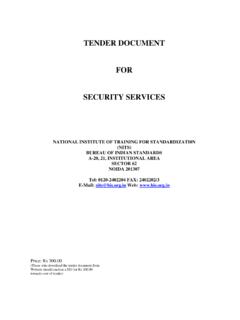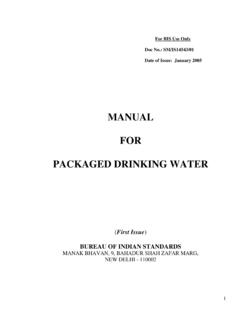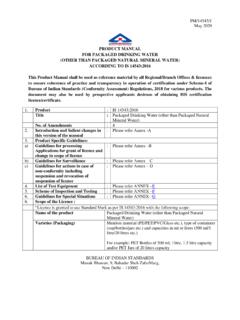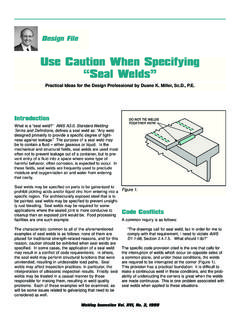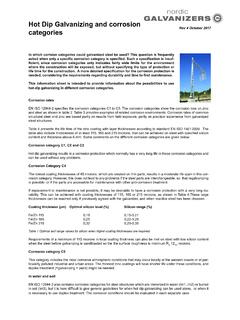Transcription of WIRE ROPE manual - Bureau of Indian Standards
1 1 DOC manual DATE OF ISSUE 17 MARCH 2008 manual FOR WIRE ROPES AS PER Indian STANDARD SPECIFICATIONS ( 1855,1856,2266,2365,2581,2762,13156 ) (First Issue) Bureau OF Indian Standards MANAK BHAVAN 9,BAHADUR SHAH ZAFAR MARG, NEW DELHI 110002 2 TABLE OF CONTENTS TITLE PAGE NO FOREWORD 3 SECTION I PRODUCT DESCRIPTION SECTION II SPECIFICATIONS SECTION III MANUFACTURE AND CONTROLS SECTION IV INSPECTION & TESTING - METHODS OF TEST TEST EQUIPMENT SECTION V CRITERIA FOR CERTIFICATION SECTION VI ANNEXES ( Refer Latest Information Available on Intranet.)
2 3 FOREWORD This is the first issue of a comprehensive manual for exclusive use of BIS inspection personnel engaged in the inspection and certification of products manufactured in accordance with Indian Standards . The scope of this manual covers wire ropes conforming to the various Indian Standards , their manufacture, quality conformance inspection, sampling and testing. The objectives for preparation of such manuals are : a) To bring uniformity in inspection procedures b) To remove any ambiguity in interpretations c) To help the consumers get certified materials meeting their requirements d) As a safety item, ensure complete conformance to the specifications, thereby meeting the statutory regulations, as for example, for use in mines, hoists, elevators etc.
3 , e) To save on the inspection time and cost f) To help the manufacturers in standardizing their product range , minimize rejection and thereby effect requisite cost control and economy Wire ropes industry is one of the earliest founded, to meet the growing needs of basic industries like mining, shipping, reinforced electrical conductors for transmission, transportation, etc. Starting with coconut fibre ropes used for lashing , mooring and anchoring, to jute fibre, for multifarious usages, on to Manila ropes and with the rapid industrialization leading to oil exploration, coal mining and drilling for other ores and minerals, the introduction of steel wires, the demand for wire ropes has grown many folds.
4 With the change in the needs, the designing of ropes also underwent major changes, in the construction of the core, overlay, weight requirements etc. Natural fibre cores have led to hard polythene/ poly- propylene strands ( NYLON) ropes. The figures in subsequent pages illustrate the different types of wire ropes as per the Indian Standard Specifications. To understand the constructional details for designing a wire rope , the following terminology should be clearly understood. Rope diameter, length , Lay type and direction, tensile designation, type of core and strands 4 The manual has been divided into following sections : Section I Product Description Section II Specifications Section III Manufacture and Controls Section IV Inspection & Testing - Methods of Test - Test Equipment Section V Criteria for Certification Section VI Annexes The inspection personnel should thoroughly familiarize themselves with the manual and its contents to facilitate an objective and impartial inspection.
5 THIS DOCUMENT IS INTENDED FOR INTERNAL USE BY BIS INSPECTING OFFICERS WHO SHOULD HOWEVER DO NOT TREAT SUCH DOCUMENT AS REPLACEMENT FOR REFERRED Standards OR THAT OF RELEVANT SCHEME FOR TESTING AND INSPECTION (STI). Standards AND OTHER DOCUMENTS ( STI ETC.) REFERRED ARE AS APPLICABLE AT THE TIME OF PREPARATION OF manual HOWEVER, LATEST Standards /OTHER DOCUMENTS AS IMPLEMENTED SHALL BE REFERRED. 5 SECTION I BRIEF DESCRIPTION OF PRODUCTS Wire ropes are composite construction of strands of fibre or steel or both, bunched to form a core surrounded by stranded and twisted cores.
6 A wire rope is designated by the over all diameter, the number of strands, number of wires per strand, the cores, the type of lay and the length etc. Therefore a typical order or technical enquiry should comprise of the following : a) Dimensions- Diameter and length of rope b) Details of construction - Number of strands Number of cores Number of strands per core, Direction and type of Lay Type of core Type of construction Tensile designation c) The intended purpose of use d) The fittings required The Glossary of Terms relating to Wire ropes are covered in the Indian Standard IS 2363 : 1977 Glossary of Terms relating to wire ropes ( first revision).
7 The IS 6594:2001 Technical Supply Conditions for Steel Wire ropes and Strands ( Second Revision) is an important adjunct to this manual . Construction and Technical Requirements To understand the construction and technical requirements of a wire rope the following definitions are important and are suitably explained by the accompanying illustrations.: / Illustration of a complete wire rope with details / In the illustrated figure above, the legend is as follows : DIMENSIONS 1. Length 2. Diameter ( in mm ) CONSTRUCTION 3.
8 Number of Strands 4. Number of wires per strand 5. Wire placement 6. Direction of Lay 7. Type of Lay Ordinary/ Lang 8. Type of core- Fibre CF / Steel Wire CWR 9. Type of construction 6 TENSILE DESIGNATION - 1420 / 1570 / 1770 / 1960 ARRANGEMENTS OF WIRES IN STRAND The typical designation for a rope through connecting symbols is given below : The connecting symbols used are : - / : + x Typical Illustration of construction is designated as : 9-9-1 or 12-6F-6-1 Single operation ( Equal or parallel Lay ) 12/6-1 or 18/12/6-1 Multiple operation in the same direction ( Cross Lay ) 12 : 6-1 or 18:12.
9 6-1 Multiple operation in the same direction ( Contra lay ) 6+6-6-1 or 14-7+7-7-1 Warrington Layer 6-1 or 12-F ( Fibre) Centre Strand 6x19S-CF General rope with one layer of strands; Core fibre CF 11x7 : 6x7-CF Rotation resistant , multiple operation ( 3 Layers) contra lay between outer layer and first layer of strands, fibre Core 18x 7 : 12 x7/6x7-CWS Rotation resistant multiple operation ( 3 Layers) contra lay between outer layer and second layer and Cross Lay between Second and First lay- Core wire strand (CWS) INTENDED USAGE & ACCESSORIES REQUIRED : Are to be given by the purchaser in his technical query / Purchase order to enable right selection/ supply by the manufacturer.
10 For example, as per IS 1855: 2003, Wire ropes for use in mines shall be of round, multi strand, rotation resistant or flattened strand type . The core can be of fibre or steel. The wire ropes for general purposes as per IS 2266 : 2002 specifies the type, construction, rope grades and the range of sizes. Wire ropes can be supplied as black or galvanized depending upon customer requirements. Joints are also permitted depending upon the applications. Pre-formed wire ropes are generally used as they have superior flexibility and have better bending resistance.


